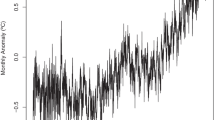Abstract
We use the Empirical Mode Decomposition (EMD) method to study the decadal variations in polar motion and its long-term trend since year 1900. The existence of the so-called “Markowitz wobble”, a multidecadal fluctuation of the mean pole of rotation whose nature has long been debated since its discovery in 1960, is confirmed. In the EMD approach, the Markowitz wobble naturally arises as an empirical oscillatory term in polar motion, showing significant amplitude variations and a period of approximately 3 decades. The path of the time-averaged, non-cyclic component of polar motion matches the results of previous investigations based on classical spectral methods. However, our analysis also reveals previously unnoticed steep variations (change points) in the rate and the direction of secular polar motion.
Similar content being viewed by others
References
Chen Y. and Feng M.Q., 2003. A technique to improve the empirical mode decomposition in the Hilbert-Huang transform. Earthq. Eng. Eng. Vib., 2, 75–85.
Chow G.C., 1960. Tests of equality between sets of coefficients in two linear regressions. Econometrica, 28, 591–605.
Dickman S., 1981. Investigation of controversial polar motion features using homogeneous International Latitude Service data. J. Geophys. Res., 86(B6), 4904–4912.
Dickman S., 1983. The rotation of the ocean-solid Earth system. J. Geophys. Res., 88(B8), 6373–6394
Dickman S., 2000. Tectonic and cryospheric excitation of the Chandler Wobble and a brief review of the secular motion of Earth’s rotation pole. In: Dick S., McCarthy D. and Luzum B. (Eds), Polar Motion: Historical and Scientific Problems, IAU Colloquium 178. Vol. 208, 421–436.
Dumberry M., 2008. Gravitational torque on the inner core and decadal polar motion. Geophys. J. Int., 172, 903–920.
Dumberry M. and Bloxham J., 2002. Inner core tilt and polar motion. Geophys. J. Int., 151, 377–392.
Gross R.S., 1990. The secular drift of the rotation pole. In: Boucher C. and Wilkins G.A. (Eds), Earth Rotation and Coordinate Reference Frames. International Association of Geodesy Symposia 105. Springer-Verlag, Heidelberg, Germany, 146–153.
Gross R.S., 2007. Earth rotation variations-long period. In: Schubert G. (Ed.), Treatise on Geophysics 3, 239–294. Elsevier, Amsterdam, The Netherlands, ISBN: 9780444527486, DOI: 10.1016/B978-044452748-6.00057-2.
Gross R.S. and Vondrák J., 1999. Astrometric and space-geodetic observations of polar wander. Geophys. Res. Lett., 26, 2085–2088.
Höpfner J., 2004. Low-frequency variations, Chandler and annual wobbles of polar motion as observed over one century. Surv. Geophys., 25, 1–54.
Huang N.E. and Shen S.S. (Eds), 2005. Hilbert-Huang Transform and its Aapplications. World Scientific, Singapore. ISBN: 978-981-256-376-7 (hardcover), 978-981-4480-06-2 (ebook).
Huang N.E., Shen Z., Long S.R., Wu M.C., Shih H.H., Zheng Q., Yen N.-C., Tung C.C. and Liu H.H., 1998. The empirical mode decomposition and the Hilbert spectrum for nonlinear and non-stationary time series analysis. Proc. R. Soc. London A, 454, 903–995.
Huang N.E. and Wu Z., 2008. A review on Hilbert-Huang transform: Method and its applications to geophysical studies. Rev. Geophys., 46, RG2006, DOI: 10.1029/2007RG000228.
Kim D. and Oh H.-S., 2009. EMD: a package for empirical mode decomposition and Hilbert spectrum. R Journal, 1, 40–46.
Lambeck K., 2005. The Earth’s Variable Rotation: Geophysical Causes and Consequences. Cambridge University Press, Cambridge, U.K.
Markowitz W., 1960. Latitude and longitude, and the secular motion of the pole. In: Runcorn S.K. (Ed.), Methods and Techniques in Geophysics. Interscience Publishers, London, U.K, 325–361.
McCarthy D.D. and Luzum B.J., 1996. Path of the mean rotational pole from 1899 to 1994. Geophys. J. Int., 125, 623–629.
Olivieri M. and Spada G., 2013. Intermittent sea–level acceleration. Global Planet. Change, 109, 64–72.
Poma A., 2000. The Markowitz wobble. In: Dick S., McCarthy D. and Luzum B. (Eds), Polar Motion: Historical and Scientific Problems, IAU Colloquium 178. Vol. 208, 351–354.
Poma A., Proverbio E. and Uras S., 1991. Decade fluctuations in the Earth’s rate of rotation and long–term librations in polar motion. Il Nuovo Cimento, C14, 119–125.
Ponte R., Rajamony J. and Gregory J., 2002. Ocean angular momentum signals in a climate model and implications for Earth rotation. Clim. Dyn., 19, 181–190.
Torres M.E., Colominas M.A., Schlotthauer G. and Flandrin P., 2011. A complete ensemble empirical mode decomposition with adaptive noise. In: 2011 IEEE International Conference on Acoustics, Speech and Signal Processing (ICASSP). The Institute of Electrical and Electronics Engineers, Piscataway, NJ, 4144–4147, DOI: 10.1109/ICASSP.2011.5947265.
Vicente R. and Currie R., 1976. Maximum entropy spectrum of long-period polar motion. Geophys. J. Int., 46, 67–73.
Vondrák J., 1985. Long-period behaviour of polar motion between 1900.0 and 1984.0. Ann. Geophys., 3, 351–356.
Vondrák J., Ron C., Pešek I. and Cepek A., 1995. New global solution of earth orientation parameters from optical astrometry in 1900–1990. Astron. Astrophys., 297, 899–906.
Wang X.H., Wang Q.J. and Liu J., 2012. Application of empirical mode decomposition in the ultra short-term prediction of polar motion. Acta Astronomica Sinica, 53, 519–526.
Wessel P. and Smith W.H.F., 1998. New, improved version of Generic Mapping Tools released. EOS Trans. AGU, 79, 579.
Wu Z. and Huang N.E., 2009. Ensemble empirical mode decomposition: a noise-assisted data analysis method. Adv. Adapt. Data Anal., 1, 1–41.
Wu Z., Huang N.E., Long S.R. and Peng C.-K., 2007. On the trend, detrending, and variability of nonlinear and nonstationary time series. Proc. Nat. Acad. Sci., 104, 14889–14894.
Young I.T. and Van Vliet L.J., 1995. Recursive implementation of the Gaussian filter. Signal Process., 44, 139–151.
Author information
Authors and Affiliations
Corresponding author
Rights and permissions
About this article
Cite this article
Spada, G., Galassi, G. & Olivieri, M. Empirical mode decomposition of long-term polar motion observations. Stud Geophys Geod 59, 200–211 (2015). https://doi.org/10.1007/s11200-014-1151-4
Received:
Revised:
Accepted:
Published:
Issue Date:
DOI: https://doi.org/10.1007/s11200-014-1151-4




